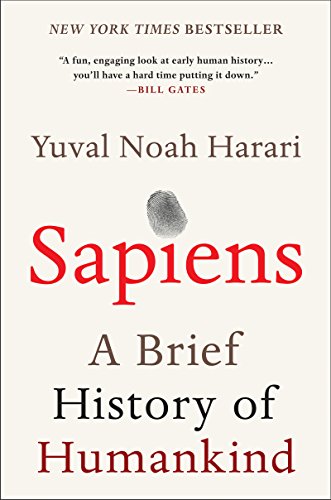

This article is an excerpt from the Shortform summary of "Sapiens: A Brief History of Humankind" by Yuval Noah Harari. Shortform has the world's best summaries of books you should be reading.
Like this article? Sign up for a free trial here .
What is the future of Homo sapiens? What might future human evolution look like?
Future human evolution will probably go in one of three directions: biological engineering, cyborg engineering, or inorganic life engineering. Each comes with its own advantages and potential problems.
We’ll look at each in turn and discuss the possibilities of the future evolution of man and how we are evolving.
The Future of Human Evolution
The future of our species may be relatively short, not because we cause ourselves to go extinct, but because we become an entirely new species. This is the future of human evolution.
For almost 4 billion years, species have evolved according to the principles of natural selection. For example, proto-giraffes who had longer necks than their contemporaries could reach higher branches and access more food. Therefore, they had a better chance of survival and passing on their genes. According to science, this wasn’t the product of intelligent design. It was the product of surviving animals passing on the characteristics that led to their survival.
For the last 4 billion years, species, including Sapiens, have been constrained by these laws of natural selection, but today, we’re on the brink of replacing natural selection with intelligent design.
With the Agricultural Revolution came a huge leap forward in the move from natural selection to intelligent design. This is when Sapiens started mating animals. Rather than merely wishing for slow, fat chickens, a sapiens could mate a fat hen with a slow cock to produce, fat, slow offspring. In this way, Sapiens sped up the natural selection process, manipulating what characteristics it selected. Still, Sapiens had no way to give entirely new traits to chicken offspring. They had to work only with the traits that arose naturally in chicken.
Today, scientists can introduce new traits into species, traits that species didn’t contain in the wild. For instance, in 2000, French scientists implanted a gene from a fluorescent green jellyfish into a rabbit embryo to create a fluorescent green rabbit. This may hint at what’s to come with the future evolution of man.
All the revolutions, from the Cognitive Revolution to the Industrial Revolution, have been momentous, but none except the Scientific Revolution has altered our biology. Future human evolution may be the most important revolution in our biology in the history of life on earth. We are evolving.
The Future of Intelligent Design
In the future, intelligent design could replace natural selection in one of three ways (or a combination of the three): biological engineering, cyborg engineering, or inorganic life engineering. This will affect of future of Homo sapiens. We’ll look at each in turn.
Future Human Evolution, Way #1: Biological Engineering
This is when scientists intervene with an organism’s biology to change its physical, behavioral, or emotional characteristics. For example, in the past, we did this through castration: we could make a bull less aggressive or preserve a young boy’s soprano voice by removing his testicles.
Recent examples of biological engineering include:
- Genetically engineering E. coli to function as biofuel and insulin.
- Introducing worm genes into pigs, turning pork’s omega 6 fatty acids into omega 3s, therefore making pork healthier for humans to eat.
- Improving the memories and learning skills of mice.
Researchers are even planning to bring back to life species that are long extinct, including Neanderthals.
But all biological engineering projects are controversial. Religious activists say man shouldn’t “usurp God’s role” by creating new species. Animal rights activists fight against the suffering caused to animals used in intelligent design experiments. Human rights activists worry that genetic engineering will lead to the creation of superhumans who could wield power over the rest of us. This is a danger of the future evolution of man.
It’s true that we’re on the brink of being able to tinker with genetically engineering humans. This could potentially turn us into a different species altogether. Many people have ethical objections to this possibility, but those objections probably won’t stand in the way for long. For instance, if we discover a way to cure Alzheimer’s that also happens to improve the memories of healthy people, will ethics and politics really be able to keep healthy humans from taking advantage of this discovery?
Future Human Evolution, Way #2: Cyborg Engineering
This is when scientists combine inorganic parts with organic life. For example, humans (organic life) with bionic hands (inorganic) might be considered cyborgs.
Today, most of us are cyborgs: We have pacemakers and hearing aids, and even cell phones and computers have become a part of us, storing and processing data and therefore relieving our brains of those tasks.
Recent examples of cyborg engineering include:
- Research into creating bionic insects. Scientists plan to implant insects with inorganic material like electronic chips, allowing them to transmit data from across enemy lines.
- Research into a retinal prosthesis, a microchip implanted in the eye that would take in light and turn it into electrical signals that talk with nerve cells in the retina, allowing blind people to see.
- Bionic arms that are controlled entirely by the thoughts of the users.
The most ambitious current cyborg project aims to create a brain-computer interface that would allow two-way communication between the two. This brings up all sorts of questions about how we define identity. If we can download our memories to a collective memory bank and then directly access the memories of others, remembering experiences as if they had happened to us personally, what does this mean about the nature of the self? What would define your sense of self if everyone could have the same experiences you did by accessing your external memory? These are important questions to ask when contemplating the future of Homo sapiens.
Future Human Evolution, Way #3: Inorganic Life Engineering
This is when researchers create beings out of completely inorganic materials. This life could evolve independently of the person who created it. For example, computer programs that learn and evolve on their own would be examples of inorganic life engineering.
Computer viruses are the prototype for this type of being. Although they’re not intelligent, they can spread and multiply on their own, and even evolve. Mutations, either the result of an intentional or unintentional flaw by the virus’s programmer, can affect the virus’s evolution. If the mutation happens to be one that makes it easier for the virus to spread through the Internet and harder for it to be caught by antivirus programs, the virus will evolve into a “species” with these qualities.
Potential, imminent advances in this field make us question how we define “life.” If we can download the contents of our brains onto a hard drive and then run that hard drive on our laptops, does the laptop now “think”? Does it feel? If it does think and feel, is it you thinking and feeling (it’s your brain, after all). If it’s not you, who is it?
Currently, the most ambitious inorganic life engineering project is being conducted by the Human Brain Project. The team is working on creating a human brain inside a computer. If it succeeds, with all the neural networks of the brain exactly replicated with electronic circuits, is that computer a person?
These are questions we just don’t have answers to yet, because this is the first time in history we’ve had reason to ask them. They indicate the issues will face in the future of human evolution.
DNA Mapping
Even though some of these advances are far in the future, we’re already dealing with the consequences of biological engineering, cyborgs, and inorganic life. The future of human evolution is happening now. Landmark advances in DNA mapping force us to ask questions now that will be even more relevant tomorrow.
It took fifteen years to map the human genome, but today you can have your DNA mapped in a few weeks. The ease cheapness of DNA mapping has brought personalized medicine, but it’s also brought ethical issues and new questions:
- Should insurance companies be allowed to ask for information on your DNA to check for predispositions for disease (or reckless behavior)?
- Could employers select employees based on DNA that indicates characteristics they want in an employee?
- If you develop a new species, can you patent its DNA sequences? For instance, you can own a chicken, but can you own an entire species of chicken? Would it be possible, in the future, to invent and own an entirely new species of human?
———End of Preview———

Like what you just read? Read the rest of the world's best summary of "Sapiens" at Shortform . Learn the book's critical concepts in 20 minutes or less .
Here's what you'll find in our full Sapiens summary :
- How Sapiens outlived and outlasted the 8+ other human-like species on Earth
- The 3 critical revolutions in human existence that led to our domination of the planet
- How much of what powers our world today is really just a shared mass delusion
- What the future of humanity might look like






